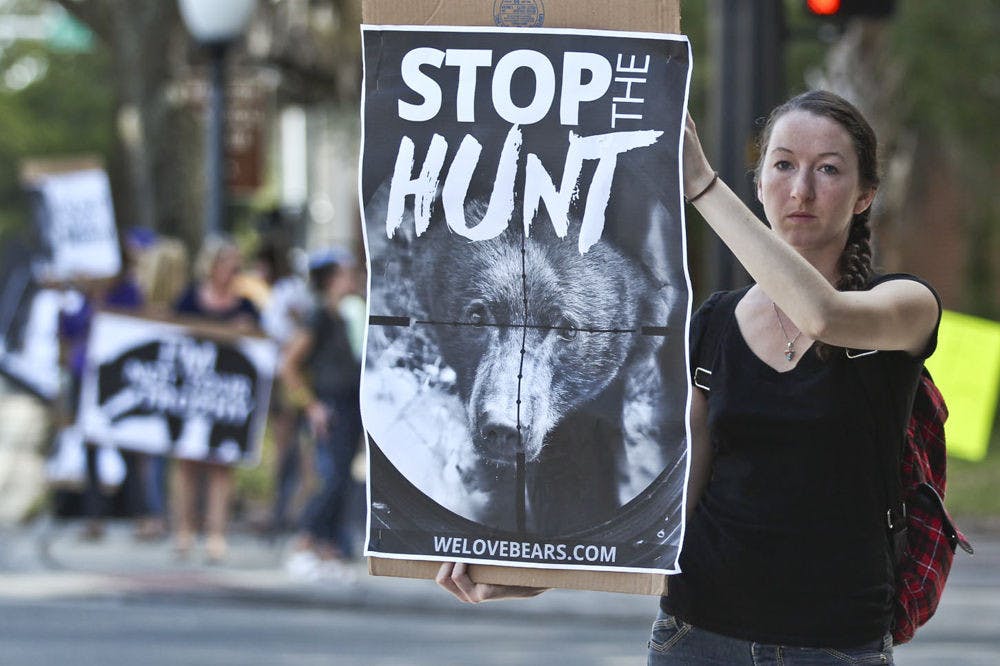The hunt was on — and then closed the second day.
By Sunday, 295 black bears were reported to have been taken statewide. The Florida Fish and Wildlife Conservation Commission said this number "is well within the allowable range of a conservative hunt" and ended the season.
The statewide harvest objective was set at 320.
The bear season was set to run until Friday unless the harvest objective was met in any of the four Bear Management Units.
After the first day, Saturday, the commission found harvest objectives were met in the East Panhandle and Central units. These units were not open Sunday.
The North and South units were closed Sunday night.
The goal was "to stabilize growing bear populations, as one part of FWC’s overall approach to managing bears," according to the commission. There were about 3,500 black bears living throughout fragmented regions in the state. Seven bear management units were created in 2012 as part of the commission’s 10-year black bear management plan.
The bear management unit harvest totals as of press time were:
• East Panhandle: 112 bears
• Central: 139 bears
• North: 23 bears
• South: 21 bears
The harvest objectives were set at:
• East Panhandle: 40 bears
• Central: 100 bears
• North: 100 bears
• South: 80 bears
"We underestimated hunter success for the first day," said Diane Eggeman, the commission’s director of Hunting and Game Management Division.
The larger numbers in the East Panhandle is an indicator of the region’s increasing bear population, said Thomas Eason, the commission’s director of the Division of Habitat and Species Conservation.
Bear permits were available from Aug. 3 to Friday, and 3,778 were sold. More than $376,900 made from permit sales is planned to help fund reduction of human-bear conflicts, according to the commission.
Commission officers and biologists were at each of the 33 bear check-in stations to collect data for future management.
Standing in the vast yellow field surrounding the Micanopy State Maintenance Facility, Brian Scheick, a commission bear research biologist, said biologists at the check-in stations were to measure captured bears’ length from nose to tail and chest girth and estimate their weight. They were to pull a premolar to determine age and mark the bears with a blue tag.
The commission does not have individual check-in numbers yet.
Cindy Myers fiddled with her new camera on the field in her black Hummer. The 62-year-old St. Petersburg resident drove to Micanopy on Friday night to monitor the station throughout the weekend as part of the Stop the Florida Bear Hunt movement. She said she wanted to make sure everything was done properly.
This was her first time participating in a movement.
"I’m just trying to stop it from happening next year," she said. "It hit my heart."
The cause encouraged others to take on their first activist role.
Kelsey Jones was so surprised to learn the extent of the statewide black bear hunt that she skipped her sustainability class, drove downtown and picked up a poster.
The UF political science and sustainability studies junior waved her "Stop the Bear Hunt" poster on a corner of Main Street and University Avenue along with about 50 others to protest against Florida’s bear hunt Friday from 11:30 a.m. to 1 p.m. It was one of 12 protests around the state happening simultaneously.
"Students should have a voice while they’re here," said Jones, 21, one of the founders of Gators for Paynes Prairie, behind a pair of retro, rounded sunglasses.
Anita Smith, 54, and Jane Windsor, 62, were also new to the action. The Gainesville residents followed the movement on Facebook before joining the rally.
"I hope that we can make a difference," Smith said. "It doesn’t seem like we are, but I hope we can."
Adam Sugalski, a Jacksonville resident, started the Stop the Florida Bear Hunt Facebook page and helped coordinate the protests Friday. He said the issue unified the state.
"My group was a catalyst of bringing people together," he said. "It was all for the animals. I’m blown away by this."
He said he took a lot of photos of dead bears over the weekend. If he talked about it, he said he might cry.
"People need to lose their jobs," he said over the increased numbers in the East Panhandle unit. "They promised this wouldn’t happen. It’s a monstrosity what happened to our bears this weekend," he said.
There was criticism and there was protest, but for better or for worse, the first bear season in 21 years is over.
Contact Alyssa Fisher at afisher@alligator.org and follow her on Twitter @AlyssaLFisher
Karrie Ford, 27, protests against the Florida bear hunt at the Stop the Bear Hunt Rally at the intersection of Main Street and University Avenue on Oct. 23, 2015. "The number of bears in Florida versus the number of hunting permits sold just doesn't make sense," she said.
Protesters cheer as a truck honks in support of the rally at Main Street and University Avenue on Oct. 23, 2015. Over 25 people gathered to oppose Florida's first bear hunt in about two decades.






